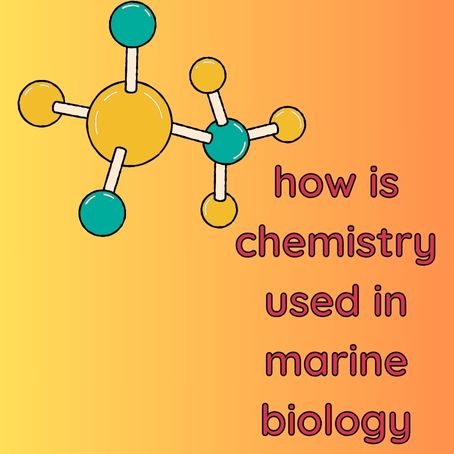Chemistry contributes substantially to marine zoology since it enables marine scientists to know the marine ecosystem together with its constituent parts including biological, chemical, and physical factors. Here are key ways in which chemistry is used in marine biology:
Analysis of the chemical composition of water
Determining the salinity, and pH as factors that determine the viability of marine water.
Evaluating the status of nitrogen, phosphorus, and silicates is fundamental for primary activities like phytoplankton growth.
Oxygen content is assessed to determine the ability of aquatic zones and their life forms to exist in specific regions.
Ocean Acidification
- Chemistry contributes to the scanning of the dissolution of CO2 in the atmosphere into water resulting in changes in the pH of water; this alters the state of coral reefs, shellfish, and other organisms having carbonate compounds.
Biogeochemical Cycles
Carbon Cycle: It identifies the transfer of biogeochemical carbon between the ocean, air, and marine organisms.
Nitrogen Cycle: Involves the analysis of active processes like fixing nitrogen and removing it which are symbiotic to the oceanic biosphere.
Toxicology and Pollution
Chemistry is utilized in analyzing the impacts of pollution on oceanic organisms for instance plastic, oil spills, and metals.
To learn how phytoplankton and other plants grow under the sun, with carbon dioxide and nutrients for purification via photosynthesis.
To learn the activities of respiration in marine life and their impacts in the carbon cycle.
Enzyme and Hormonal Chemistry
For example, in marine life, to focus on metabolic enzymes or hormones that have a role in growth and reproduction.
Marine Natural Products
For instance, the chemicals synthesized by marine life enable medicines, biotechnology, and materials development.
Climate Change Studies
Learning the chemical functions that influence how much heat the ocean absorbs and stores, how the ocean serves as a greenhouse gas sink and how it mitigates climate changes.
The combination of chemistry and biology in marine life enables marine biologists to tackle and address issues on biodiversity, conservation, and sustainable use of resources in the marine realm.
how is chemistry used in marine biology definition?

The Contribution of Chemistry to the Understanding of Marine Life
The brackish water organisms as well as the biology of the oceans and oceanic life form the basic components of marine biology, and chemistry enables one to have an overall view of the complex relations, which are to be found in marine ecosystems. Everything from sea plants, animals, and even the water vapour contains biochemistry. This current paper seeks to explore the connection between chemistry and marine biology with a focus on water chemistry assessment of water quality, metabolic assessment of aquatic organisms, and the geochemical cycle together with measures taken to control pollution.
Ocean Water Chemistry and Water Properties
One of the most interesting activities of marine science is the determination of the seawater ratios of various species and even the proportional volumes of the different components. It is interesting that all the species of these marine organisms live within the oceans, which are better defined as a body composed of specific salts, gases, and organic substances which are already dissolved.
Salinity and pH: The concentration of salt in a water body affects marine life; this concentration is referred to as salinity. Marine ecosystems, however, can be quantitatively defined by applying a set of coordinates in three-space using two principal physical parameters: salinity and pH. The dissolution of corals and the ecosystems dependent upon them is all too easily triggered by changes in the complex structures of coral reefs that are sensitive to pH variations.
Dissolved Gases: Further, estimating the amount of gases dissolved in water such as oxygen, carbon dioxide etc. is important for the assessment of the living conditions in the marine waters. Though one could enrich stocking density, acknowledging the amount of oxygen available for fish and other more or less active organisms is important too – as well as other supporting parameters.
Ocean Acidification
One of the main problems that stems from the large amount of carbon dioxide (CO₂) emissions mostly made by developed nations is ocean acidification. While this is an issue that should be tackled in the view of global warming, I believe it is equally important for oceanographers to explore because it aids the tone in which high levels of carbon dioxide will impact marine ecosystems, particularly corals, some mollusks,
and plankton that build their skeletons and shells out of calcium carbonate. Considering that pairs of calcium ions and carbonate ions are formed under high concentration, and alkaline carbonate ions are needed, it can be argued that while carbon sinks are efficient in controlling the alkaline nature of marine water, they have a negative impact by increasing acidity levels.
Carbon Cycle: Annually, a vast quantity of CO₂ trapped in the oceans and atmosphere is able to assimilate copious amounts of CO₂ each year. Knowledge of the mechanisms by which carbon occurs in the ocean, atmosphere, and marine biota is of assistance in estimating likely impacts of climate change.
Nitrogen Cycle: The emergence of the concept of marine ecosystem development expansion emphasizes the importance of processes such as nitrogen fixation, nitrification, and denitrification among others for life support. These processes are the tasks whose explanations are the objectives of marine chemists, particularly the cycle of nutrient use and its effects on the biota of the given area.
Pollution and Toxicology
Out of the factors that contribute to the pollution of the marine environment the most damaging could be categorised such as heavy metals, oil, plastics and agricultural sludge. The field of chemistry is vast and has various approaches to offer for such a great catastrophe.
Heavy Metals: Marine mammals like whales may possess dangerous metals like mercury and lead, which if ingested are deleterious to the marine ecosystem as well as to humans. Thus chemists will of course keep an eye on these patients and seek to conduct experiments on sea mammals and water sources to see their symptoms.
Oil Spills: As for oil spills, so please chemistry will also be needed in this case if there is an analysis of the oil that was released, what type it is, what is its structure and what it degraded to; this will contribute to the clean up exercise too.
Microplastics: Microplastics are pollutants being studied based on their effective chemical composition, structure, and morphology as well as biological activity evidenced by the assessment of organisms.
Photosynthesis and Primary Production of Organic Matter Furthermore, marine biology in general is dependent on photosynthesis which is done by primary wholesalers like phytoplankton and algae. The term photosynthesis covers several chemical processes in which carbon dioxide and water are used to make glucose and oxygen as by-products. Chemists who examine these procedures consider them as signs of primary production which is at the foundation of the food chains in the ocean waters.
Isotope Analysis in Marine Biology Most importantly, the stable 13C isotope, 15N isotope and,18O isotope are all isotopes that matter in marine biology. From isotope analysis, there are insights on nutrition and migratory patterns of populations, and these also tell more about the prevailing conditions at that time. For instance, the isotopes of fish provide information of where they foraged and the distance moved as well as what the sediment from the sea describes regarding the prevailing climatic conditions at that period.
Biomineralisation Processes. As studies indicate, biomineralisation is the phenomenon whereby a living organism, more so, those found in the sea, are able to form minerals which occur in the form of shells, skeletons and many other structures. Many marine organisms such as corals and molluscs form shells that are impregnated with calcium carbonate, and then this science examines the living organisms and the structures of deposition of this calcium carbonate. This will help to estimate the reaction of the oceanic organisms to both the changed oceanic chemistry and resource availability that is expected due to the changes which will take place to the ocean life in the near future.
Chemistry of Hormones and Enzymes
By enzymes, every process within the ocean is somehow brought to existence, and for that reason, every existing system is under the control of hormones. In the context of this explanation, the tasks or roles of the chemist marine residents are mainly focused on addressing these molecules in order to explain some processes like metabolism, and reproduction, among other activities that require such molecules.
Metabolic Pathways: The metabolic pathways are the ones that comprise the enzymes that help in digestion and excreting energy as well as building up the tissues of the organisms.
Hormonal Regulation: Hormones in marine animals have a wide range of applications from growth and reproduction to stress responsiveness. The hormone level in the organism serves as the key integral to understanding how the organisms react to their environment.
Marine Natural Products
Marine organisms house numerous metabolites of diverse characteristics. There exist strong likelihood rates for these natural products being utilized in medicine, biotechnology, and even agriculture.
The most relevant field to the understanding of climate change in the ocean is chemistry. From a biological perspective, the situation in the ocean is aggravated by global warming, changes in salinity, and the seawater intrusion of CO2 gases.
Heat Absorption: The ocean is one of the top places where a significant proportion of heat trapped by greenhouse gases on Earth is retained. The chemistry and physics of processes in ocean water help to orient the scientist on where the heat will be and what will be done to it in the future.
Accumulation of Greenhouse Gases: Climate change, seas, ecologists concerned with CO2 and CH4 (greenhouse gases) — these are the gases which further add to the burden on our sphere of life and make it hot.
Through an insight into chemistry as a discipline that is relevant to marine biology, I have stressed the need to use the knowledge and skills acquired for the saving of marine ecosystems. In particular, water chemistry, substance circulation, and the biochemistry of water organisms can help in the solution of crucial problems such as pollution, global warming, and biological extinction through the loss of entire groups of life forms. Since the anthropogenic impact on the oceans is bound to become stronger in the near future, chemistry will always be of utmost importance for the issues of marine biology connected with the use of oceans.

